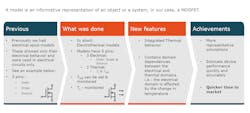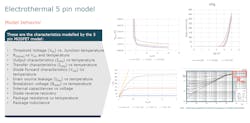Building a Better Model for Power Semiconductors
This article is part of our APEC 2022 coverage.
In the race to build faster and smaller chargers, cheaper and longer-range electric vehicles, and renewable-powered grids with battery storage, companies are pushing the envelope in the world of power electronics.
Nexperia is trying to get ahead of the game with new electrothermal models for its MOSFETs, giving its customers a more accurate way to test the devices under different scenarios before investing in a physical prototype. The company said the new models stand out from the crowd because they can accurately predict the performance of the power MOSFET over its full operating temperature range of −55 to 175°C.
“There are a lot of complex interactions between electrical and thermal performance,” said Chris Boyce, senior director of marketing and product in the power MOSFET business at Nexperia. “What you end up with is a more accurate, reliable model that you can build into your simulation engine. Ultimately, that means you can better select components without having to build any hardware, and you can get faster time to market.”
Power MOSFET Specifics
Nexperia, which is headquartered in the Netherlands, is a major player in the power semiconductor market, and it is hoping to dig even deeper roots in the sector. It was formed in 2017 as a spin-off of NXP's standard products business. It runs several manufacturing plants around the world that churn out over 250 million chips per day and more than 100 billion per year, accounting for 10% of all chips shipped globally last year.
The company has amassed a product portfolio of more than 15,000 devices, including power rectifiers, diodes, bipolar junction transistors (BJTs), MOSFETs, analog and standard logic ICs, as well as GaN and SiC devices.
But the MOSFET is the workhorse of the power electronics industry. The power MOSFET is the most popular semiconductor device in the world, due to the device’s stability under high temperatures, reduced on-state resistance (RDS(ON)), and its ability to sustain high blocking voltages and fast switching speeds. They are key components in low- and mid-voltage (less than 200 V) power supplies, dc-dc converters, and motor drives.
Most semiconductor companies create simulation models for their power MOSFETs. Customers take these models and plug them into electronic design software, where they put the semiconductor through its paces and try to identify design weaknesses before building a final prototype. But most of these models are not as detailed as they could be, said Boyce, and tend to only simulate the device at typical operating temperatures.
This is not ideal because power MOSFETs rarely operate within a tight temperature range. MOSFETs are subject to self-heating and, given that they can handle large amounts of power, are frequently placed under the hood of cars or on factory floors. Consequently, they are vulnerable to harsh temperatures, which can take a toll on the device’s performance. For instance, variations in temperatures can impact the RDS(ON) and the gate-source threshold voltage (VGS(th)) of the device.
Electrothermal Models
Nexperia said it is upgrading its electrothermal models to take these complicated relationships into account, giving its customers a more accurate tool to use when evaluating components or troubleshooting a power-system design. According to the company, its new models can recreate the performance of its MOSFETs across the full operating temperature range of its devices, from extremely hot (up to 175°C) to frigid conditions (down to −55°C).
Instead of testing physical hardware under unlikely worst-case conditions, engineers can use these electrothermal models to evaluate the performance of the MOSFET at specific temperatures ranges.
Boyce said the new models can also be used to get an early start on reducing electromagnetic interference (EMI) that is produced as an unwanted by-product of switching currents and voltages in power electronics.
Nexperia said the enhanced models, which it developed in a close partnership with a Tier-1 OEM, are available in Spice and VHDL-AMS, meaning that they can work with widely available circuit simulation tools.
The company has already rolled out advanced models for a range of its automotive-grade MOSFETs. But it is also in the process of building electrothermal models for many of its non-automotive MOSFETs, too.
Nexperia said the plan is for these electrothermal models to come standard with every new product in its MOSFET family from now on. Further out, Boyce expects the company to extend these models for other power devices such as GaN FETs.
About the Author
James Morra
Senior Editor
James Morra is the senior editor for Electronic Design, covering the semiconductor industry and new technology trends, with a focus on power electronics and power management. He also reports on the business behind electrical engineering, including the electronics supply chain. He joined Electronic Design in 2015 and is based in Chicago, Illinois.




